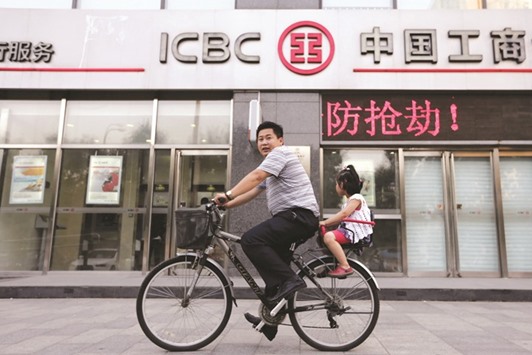Chinese lenders in 2016 likely posted their lowest interest margins since the global financial crisis, due to higher costs and fewer lucrative lending options, with the going set to get tougher as the key gauge of profitability stays under pressure.
While credit growth in China has remained strong, bad debt continues to drag on performance, analysts said, ahead of annual reports from lenders starting next week.
Margins have been hit hard after Beijing cut benchmark interest rates six times in 2014-2015 in a bid to revive a slowing economy.
The pressure on net interest margins – the difference between interest paid and earned – will continue to weigh on bottom lines across the sector in 2017, adding to financial sector vulnerability, analysts said.
At Agricultural Bank of China, margins likely fell to 2.27% in 2016, the lowest since at least 2008 and down from 2.66% a year ago, Thomson Reuters data shows.
Among China’s top five lenders, Bank of China, Industrial and Commercial Bank of China and China Construction Bank are all set to see weaker margins.
China’s central bank has moved to marginal tightening this year by raising short-term interest rates in what economists see as a bid to curb capital outflows, and as policymakers look to rein in uncontrolled lending.
Smaller banks will see a “very sharp reduction” as liquidity tightens and they face higher funding costs with the interbank borrowing rates going up, said Alicia Garcia Herrero, chief Asia Pacific economist at Natixis.
Banks tend to rely heavily on short-term, interbank lending, which connect strong lenders with weaker ones, and higher rates on these loans will result in an increase in bank funding costs.
“It’s getting very tough for smaller banks in China in terms of liquidity, cost of wholesale funding,” Garcia Herrero said.
Total credit growth in China jumped from slightly below 10% in mid-2015 to 13.5% in January this year.
The International Monetary Fund last year warned that the country’s credit growth was twice as fast as nominal GDP.
In 2016, new bank loans totalled $1.8tn – about the same size as Italy’s total economic output – and surpassed the levels of China’s massive credit-led stimulus during the global financial crisis, calculations based on central bank data show.
Rating agency S&P sees China’s loan growth, excluding public sector debt, slowing to 11% this year from an estimated 13% in 2016.
But the combined ratio of non-performing loans and special-mention loans – credit that may potentially turn sour – could rise to 6.5%-7% by end-2017, from around 6% last year, as per S&P estimates.
Yulia Wan, bank analyst at rating agency Moody’s, sees banks facing “short-term pressures, because to reduce leverage, firms in oversupply-hit sectors will be shut down or restructured, which typically means credit or economic losses for banks”.
Chinese banks’ volume of bad loans climbed to 1.51tn yuan at end-2016, the highest since 2005.
China is looking to address this with regulations, such as those aimed at bolstering oversight of opaque and shadow banking-linked financial assets, including wealth management products (WMPs).
A surge in deposits following the crackdown on high-yielding WMPs and capital outflow controls could, however, ease bad debt concerns in the near to medium term, said bankers and sector analysts.
“We have (seen deposits grow), because people can’t invest abroad so easily anymore.
They can’t get their money out to buy insurance,” said a banker at one of the top-10 listed banks, referring to mainland Chinese buying investment-linked insurance products in Hong Kong to cut their exposure to a weaker yuan.

A man and his daughter ride a bicycle past a branch of the Industrial and Commercial Bank of China in Beijing. Chinese lenders in 2016 likely posted their lowest interest margins since the global financial crisis, due to higher costs and fewer lucrative lending options, with the going set to get tougher as the key gauge of profitability stays under pressure.


